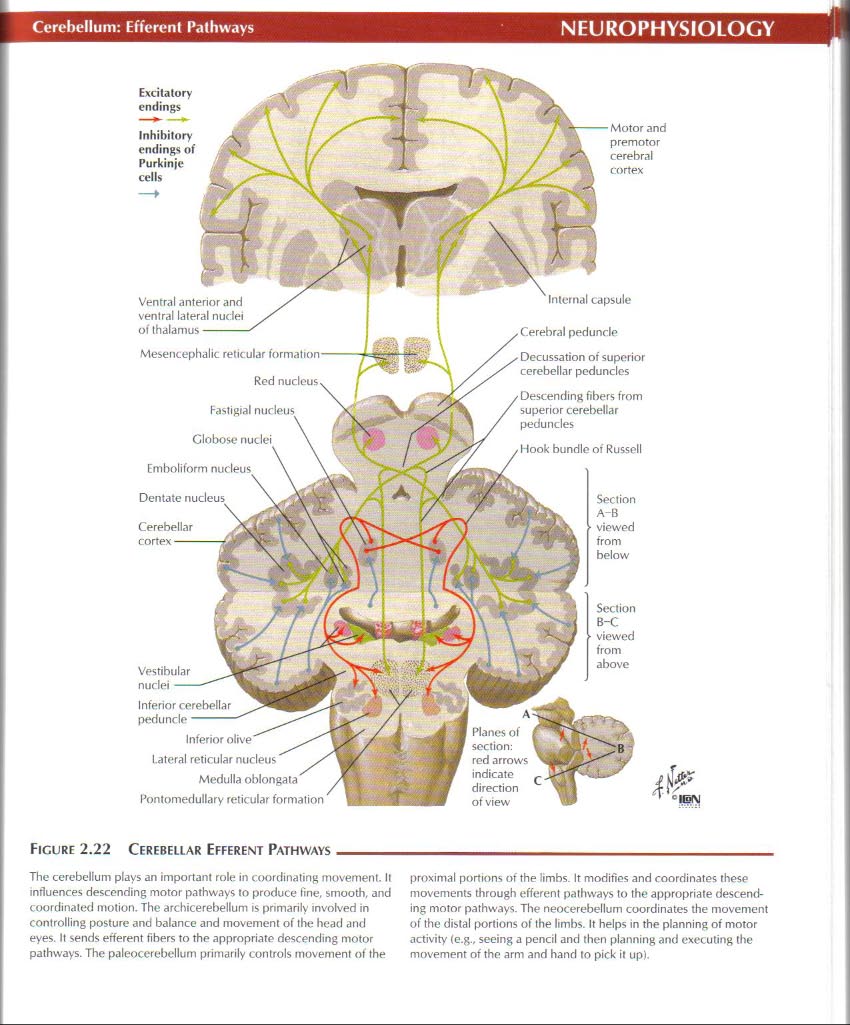netter23

Cerebellum: Efferent Pathways
NEUROPHYSIOLOGY
Inhibitory endings of Purkinjc cells
cerebral
cortex
‘ Interna! capsule
Mesencephalic reticular formatiom
Red nudeus.,
Fastigial nudeus
Clobose nuclei
Cerebral pedunde
Decussation of superior cerebellar pcduncles
Descending fibers from superior cerebellar peduncles
- Hook bundle of Russell
Emboliform nudeus
Dentate nudeus
Cerebellar
Section
A-B
viewed
from
below
Vestibular nudei-
Inferior cerebellar peduncle
Inferior olive Lateral reticular nudeus
Medulla oblongata Pontomedullary reticular formation
Planes of section: red arrows indicate direction
Section
B-C
viewed
from
above
Figurę 2.22 Cerebellar Efferent Pathways_
The cerebellum plays an important role in coordinating movement. It influences descending motor pathways to produce fine, smooth, and coordinated motion. The archicerebellum is primarily involved in controlling posturę and balance and movement of the head and eyes. It sends efferent fibers to the appropriate descending motor pathways. The paleocerebcllum primarily Controls movement of the proximal portions of the limbs. It modifies and coordinates these movements through efferent pathways to the appropriate descending motor pathways. The neocerebellum coordinates the movement of the distal portions of the limbs. It helps in the planning of motor activity (e.g., seeing a pencil and then planning and executing the movement of the arm and hand to pick ił up).
Wyszukiwarka
Podobne podstrony:
netter42 Olfactory System: PathwayNEUROPHYSIOLOGY I} Efferent fibers Granule celi (cxcited by and in
67092 netter42 Olfactory System: PathwayNEUROPHYSIOLOGY I} Efferent fibers Granule celi (cxcited by
67092 netter42 Olfactory System: PathwayNEUROPHYSIOLOGY I} Efferent fibers Granule celi (cxcited by
netter29 Proprioceptiiid Reflex Pathways: IVNEUROPHYSIOLOGY B. Stretch refie* (reciprocal inhibition
netter22 NEUROPHYSIOLOGYCerebellum: Afferent Pathways Cortical input uperior cerebellar peduncłe Mid
netter30 NEUROPHYSIOLOGY Sensory Pathways: I Spinothałamic iract lower part of medulla
netter21 Descertding Motor PathwaysNEUROPHYSIOLOGY longitudinal bundles branrh upon enlering basis p
więcej podobnych podstron